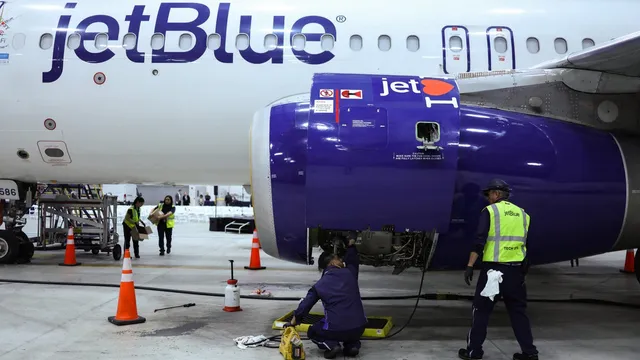
JetBlue cuts flights and staffing amid declining travel demand
2025-06-18 16:40- JetBlue's cost-cutting measures come after a reported drop in travel demand, prompting changes in flight schedules.
- The airline industry faces challenges including rising economic uncertainty and decreased consumer spending on travel.
- As JetBlue implements these cuts, the outlook for recovery in travel demand remains uncertain.
Express your sentiment!
Insights
In the United States, JetBlue announced cost-cutting measures as a response to a significant decline in domestic air travel. The airline's CEO Joanna Geraghty conveyed in a memo to staff that the anticipated recovery in demand and bookings was not materializing as quickly as hoped. As a result, this has forced the company to rely on borrowed funds to sustain operations. JetBlue's plan includes cutting less profitable routes and off-peak flights and putting a hold on refurbishing older aircraft. Despite these measures, the CEO remains cautiously optimistic that demand will eventually rebound. The airline industry as a whole has faced economic challenges exacerbated by broader uncertainties, including shifts in government spending and tariffs imposed by the Trump administration. This environment has led numerous airlines, including American Airlines and Southwest, to retract their financial projections for future years. As air travel from Western Europe to the U.S. continues to decline, JetBlue's actions reflect a wider trend in the industry as passenger numbers dwindle, influenced by both economic factors and changing consumer behaviors. The situation has seen airfares decrease, with a notable drop of 7.3 percent in May 2025 compared to the previous year. Overall, travel dynamics have shifted as international tourism from regions like Western Europe has significantly reduced, marking a serious downturn for airlines relying heavily on transatlantic travel. However, there have been minor increases in travel from Eastern Europe, indicating a mixed bag of trends within the broader market. While JetBlue aims to navigate these turbulent times by investing in premium-class services and enhancing customer experiences, such as building airport lounges and adding domestic-first class seats, the overarching difficulty remains. The cuts in flights and staff hours illustrate the ongoing battle airlines face in recovering from the recent steep declines in demand, suggesting that a return to profitability may be a longer journey than expected.
Contexts
The current situation of US airlines has seen a significant decline in travel, a trend that has been influenced by various factors including economic challenges, evolving consumer preferences, and the long-term impacts of the COVID-19 pandemic. Following a brief period of recovery after the initial waves of the pandemic, the airline industry has once again found itself grappling with reduced passenger numbers. As inflation affects disposable incomes, many consumers are prioritizing their spending, leading to a decrease in discretionary travel. Airlines have experienced a notable reduction in both domestic and international flights, as booking patterns have shifted to accommodate more budget-conscious travelers. Furthermore, the travel landscape has evolved due to the rise of remote work options and changing attitudes toward business travel. Companies are reassessing their travel policies, often opting for virtual meetings over in-person engagements. This shift, combined with increased competition from alternative travel modes such as trains and buses, has put further pressure on airlines to adjust their offerings. In response to changing demands, airlines are also focusing on enhancing their customer experience, emphasizing leisure travel and flexible booking options to attract a more diverse range of passengers. Environmental concerns have also begun to play a crucial role in travelers' decision-making processes. With rising awareness about climate change, more passengers are considering the environmental impact of air travel. This has prompted some airlines to invest in more sustainable practices, although the effects of these initiatives will take time to translate into consumer confidence and increased ticket sales. The push for sustainability, coupled with the need for innovation in passenger safety and service efficiency, has led to significant operational changes across the industry. As airlines navigate these challenges, it is essential to remain attentive to consumer trends and the broader economic environment. Adapting to new market realities, investing in technology, and enhancing sustainability efforts may provide US airlines with pathways to revitalization. However, the path to recovery remains uncertain, dependent both on external factors such as fuel prices and the ongoing reactions of the traveling public. As airlines emerge from this period of decline, the focus must be on creating resilient business models that can withstand future fluctuations in travel demand.